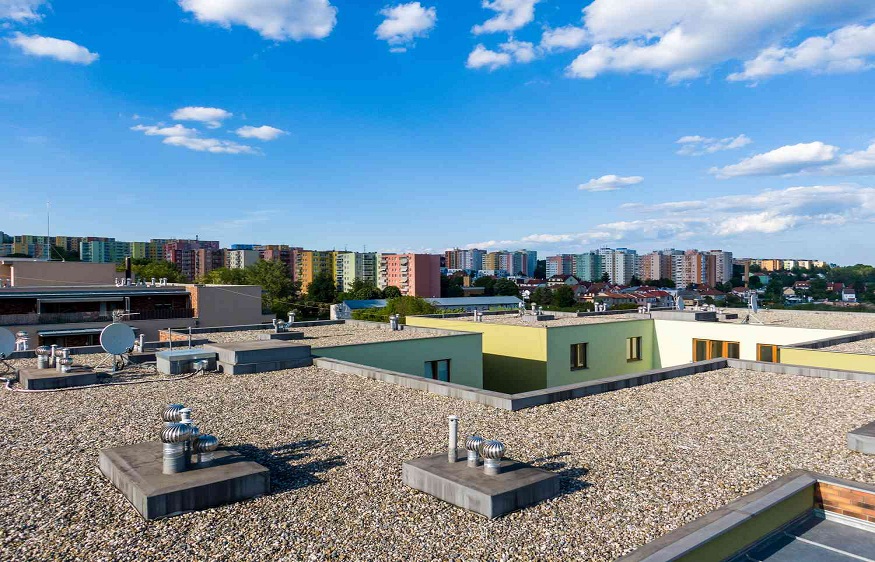Finding the Best Option for a Commercial Roofing Project
Systems and Materials for Commercial Building Flat Roofs
The purpose of this article is to help building owners, architects and contractors choose the best commercial roofing option for each project. But why install a flat roof on a building? Flat roofs are not new, nor are some proven materials that cover them. Some of these flat roofs are often very common (those covering factories, warehouses, small and large warehouse stores, apartment buildings, large public structures, and schools and universities). The design of a flat roof is both efficient and economical. The following will be discussed regarding the main roofing systems for low slope roofs.
The recently revised Manual of Low-Slope Roof Systems * (hereafter referred to as the “ Manual ”) will be cited as reference in this article. Originally written in 1970 by RL (Dick) Friclas and CW Griffin, roofing experts, this Handbook is one of the most comprehensive guides to commercial flat roofing.
The National Roofing Contractors Association ( NRCA ) website offers trusted resources for contractors on all things roofing. This user-friendly site features a comprehensive overview of materials, applications, training and other resources for contractors and building professionals. On the NRCA’s microwebsite, Everybody Needs a Roof , homeowners and building professionals can learn more about the importance of using the right roofing materials and required applications, find contractors, and even ask questions at experts on roofing components.
The 2015-2016 NRCA Market Survey http://www.nrca.net/2016-market-surveyindicated that the types of roofing systems used in the United States continue to reflect recent trends in low-slope commercial roofing applications. Survey results show that TPO (thermoplastic polyolefin) is the leader in the low-slope roofing market, capturing 40 percent of the new construction market share and 30 percent of the retrofit market share. roof. EPDM (ethylene-propylene-diene terpolymer) follows closely behind, capturing 22 percent market share in new construction and 26 percent market share in re-roofing. Modified Bitumen comes in third place with 12.4 percent market share for new construction and 14 percent market share for re-roofing.
We will now look at the roofing system options for low-slope roofs shown in the table above, starting from those capturing the lowest market shares, to those capturing the highest market shares.
Under 10 percent group
Liquid Application and Spray Foam Roofing Systems
As noted in the Handbook , the liquid applied roofing membrane system includes hot or cold applied polymer modified bitumen, single component bitumen or coal tar added urethane, and lastly, elastomer two-component urethane. Liquid-applied membrane systems require thorough preparation of the substrate, which must be dry, dust-free and free of cracks that cannot be sealed.
Metal roofing, one of the oldest systems in the world, is found in the form of bronze tiles on the Pantheon in Rome. This material was soon replaced by lead for cathedrals and castles across medieval Europe. Much of the metal roofing for low-slope roofs today is made of galvanized corrugated iron (sheet steel coated with zinc). Copper, aluminum, stainless steel and tin are also used for commercial metal roofing. The advantages of metal roofing are described as longevity, durability and heat resistance. In addition, metal roofs can withstand strong winds and impacts. However, they are a much higher upfront investment than other flat roof solutions.
Metal Roofing System on commercial building
For those who want to perfect their knowledge of the use of metal as a roofing solution for low-slope roofs, the Metal Construction Association (MCA) offers interesting resources. For this association, metal roofing is the solution of choice for commercial, institutional and industrial buildings with low-pitched roofs, because it protects against the weather, allows water to drain from the roof surface and maintains the property and occupants dry.
The MCA carries out numerous technical studies and takes part in numerous research projects in partnership with members of the industry. Its free resources are offered in the form of newsletters, technical presentations, manuals and reports.
New Metal Roofing Applications:
Metal roofing for low-slope roof structure is better known as standing seam roofing, and consists of interlocking panels laid vertically on the surface of the roof. These panels usually have a painted mill finish or clear acrylic. Some metal roofs installed on low-slope roofs require assembly by machine in order to obtain a perfect seal. A joining device is simply rolled along the panels to pinch the panel joints together.
The standing seam application allows adequate drainage of rain and snow, as it prevents water from stagnating and infiltrating. Finally, metal roofing for low-slope roofs is not susceptible to degradation under the effect of certain organic materials and, therefore, is more resistant to bad weather. You can then count on a longer service life and lower annual operating costs.
Metal roof repairs:
Multi-layer systems have been popular in North America for over 100 years. They consist of alternating layers of bitumen (asphalt) and roofing felt. The felts are reinforced, either with fiberglass reinforcement, or by layering organic felts (ply) and when bitumen is added, they form a durable roofing membrane. The number of plies of a roof means the number of layers; four-ply means a roofing membrane system of four layers of felt.
hot mop built up roofing system
Multi-layer systems are redundant, meaning that if one layer breaks down, the other layers in place provide immediate protection. These systems also have a high tolerance to the stresses to which the buildings are subjected as well as a high resistance to thermal shocks and perforations. They also offer exceptional membrane strength and toughness for proven durabili

